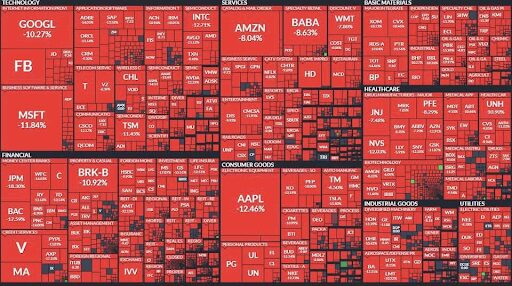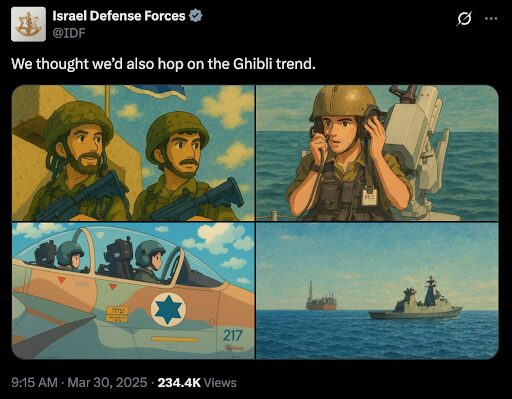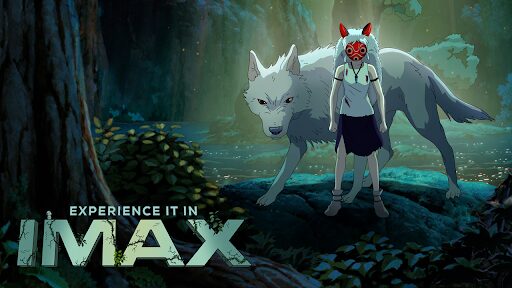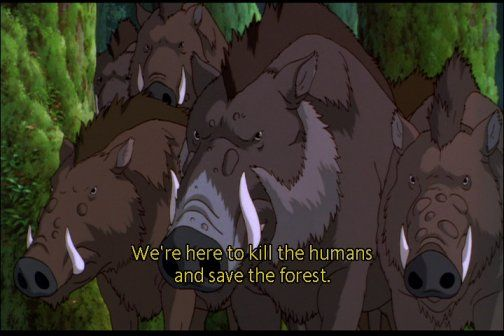
Memoirs From a Picture Show is a semi-regular column from the Merry-Go-Round staff chronicling memories, miracles, and anomalies from our time spent in cinemas around the globe. You’ve read about movies; now it’s time to read about seeing those movies in theaters.
Sometime in the back half of my college years, the cinematography nerds called me over to a laptop walkthrough of one of the nascent artificial intelligence image generators. I was looking to be impressed. I told the guy, “Give me a scene where wild parrots have taken over a supermarket in the distant apocalyptic future; lodging is in the freezer aisle, and the barracks are in the kitchen utensils aisle.” They told me the more detailed I was, the more able the program was. What I received was a puree of colors splotched across a PS2-era rendering of a warehouse.
Guys, guys, hey, guys, give me a fucking break.
The devolution of the human species is witnessed no more clearly than in the growing fascination with generative artificial intelligence. The best part about me writing about A.I. art is that I detest it so thoroughly that I’ve been able to bypass my addiction to information on this topic: I so do not give a shit about these bozos and their advancements to the dumbest tech known to mankind. I’m not qualified to write about this; however, I’m the ideal candidate to shit on it. I know China and most recently DeepSeek have been undercutting all western efforts to lead the progress of artificial intelligence by adopting open-source models in a total affront to capitalistic proprietary licensing. Translation: Remember that scene in THE SOCIAL NETWORK where Zuckerberg is asked why he released his music software for free after receiving a bid from Microsoft and in response just shrugs? With DeepSeek available for free, it’s borderline impossible for any Chinese competitors to charge for their services. Just this past January, the emergence of DeepSeek lopped off $989 billion of value in U.S. technology stocks. It becomes easier to realize why this country’s tech giants are rallying behind Trump’s war-hawking with the Middle Kingdom. The best we’ll do to compare is to call a company OpenAI wherein its core generative technologies are, in fact, privately owned. That’s awesome, but also, if we succumb to the splendorous Chinese century as we are expected to, this particular situation only gets worse for us all. Globally, the toothpaste ain’t squeezing back in the tube. We are a planet of pigs and scumbags, and sometimes it’s fun to roll in the mud, and most other times I’m hungry for a plate of lechon.

On Wednesday, March 25th, I noticed a Tweet making the QRT-farming rounds from Grant Slatton (some random, Seattle-based, blue-check-purchasing coder) where he A.I.-converted a beach photo of himself and his partner into a version that closer resembles the character styling of Hayao Miyazaki (his partner’s distinct nose and curly hair became a petite triangle and flattened locks). This was the genesis of the week’s evil.

Under that photo was a thread of other conversions Slatton had made with OpenAI’s newly upgraded Sora, followed by a timeline filled with other blue checkmarks converting their shitty iPhone pics and, most chillingly, official brands taking advantage of the bastardized tech. From Ghibli-fied porn companies, to Malaysian prime ministers, multiple esports leagues, political commentator hacks, try-hard trolls, Hindu nationalists, Mike Tyson, and a smidge of state-sponsored terrorism from The White House, only the MLB stood up to reiterate that their “Heroes of the Game” promo series was a hand-drawn collaboration with bona fide anime artists. There was no mention of artificial intelligence in the post, and most mainstream outlets and figureheads hold no public ire against the thieving tech. It’s really weird: We are as angry as we have ever been, but the things we should be throwing tomatoes at are received with, at worst, shrugs. There’s both too much hate and not nearly enough. Anything that could be said about the horrific ironies of looting Studio Ghibli’s protected imagery until GPUs start melting has already been stated ad nauseam (read: Miyazaki finds artificial intelligence to be an insult to life itself, while life itself is threatened by the ecological catastrophes this image generation is already spawning), so it’s redundant to restate the diatribes, but Jesus Christ, this stinks. As of Sunday, the A.I. conversions have slightly slowed, only casually deterred by the vicious online backlash; no formal litigation has been filed (though some failed abortion with a history in Web3 has attempted to antagonize Studio Ghibli with a falsified, A.I.-generated cease and desist letter from the Japanese studio), but Warner, Sony, and Paramount’s decision to begin monetizing fake A.I. trailers of their properties (rather than issuing copyright takedowns) spells a dark future for exterminating this infestation.

The common refrain for the past few years has been that people are disenchanted by corporations pushing artificial intelligence onto them and will inherently desire the human brushstrokes of art, to which the doldrums of reality have responded with, “Hey, we’re gonna snatch art’s catalytic converters and haul to the Chop Shop That Makes Your Dumpy Wife Look Like Ponyo.” The defenses roll in from all generations. The middle-aged owners of Run Out Groove Records, a groovy local vinyl shop in Magnolia Park that’s received hundreds of my dollars, posted a gallery of Ghibli-fied album covers along with a drawn-out caption reveling in the provocations of this new art and how this “copying” is no different than mixtape bootlegging. Under the banner of a bastardized rendition of Carole King’s TAPESTRY sat this quote from the business, which, anecdotally, encapsulates what I’ve encountered in discussions I’ve engaged in and overheard about the consequences of generative imagery: “History repeats itself: The camera didn’t kill painting; it birthed photography as a new art form. Similarly, A.I. isn’t replacing artists; it’s becoming another tool for creativity and exploration.”
Guys, guys, hey, guys, give me a fucking break.
Meanwhile, the argument from Gen Alpha and Zoomers is a series of snarled grunts, followed by a trail of drool, and then a foaming at the mouth from some sort of blood poisoning, concluding in an arterial rupture derived from the stress of needing to tell you how committed they are to their 85th attempted dopamine detox of the month (while their gooning-deprived left arm whips up into an impulsive, Strangelovian Sieg Heil).

Also on March 25th, less than 10 minutes down the road from Run Out Groove, was an IMAX re-release of Hayao Miyazaki’s 1997 opus, PRINCESS MONONOKE, at the AMC Burbank 16—the first time in my young life the films of Studio Ghibli have been shown in a multiplex without the “assistance” of a Fathom event. Everyone say, “Thank you, GKIDS and IMAX.” Row-to-row, the auditorium was packed, and the moment the light-blue studio logo landed with a thunderous drum the rage from the day washed away in an instant. MONONOKE proved triumphant in this turmoil: a film for tough times released at a period where its director could foresee that tough times were all we were capable of creating for ourselves. PRINCESS MONONOKE is a motion picture about finding a will to live whilst dying in a dead land. The wrath we incur is deserved. In response, we make amends and carry on until it is time to make amends once more. Miyazaki is communicating the legend of Ashitaka via primordial logic of our natural order. Sometimes you can tell in a rep screening when the audience is waiting for the hits. There’s an aimless air in the space you can feel in your lungs. But hundreds of us were entranced from tip to toe, every second of this hand-crafted feat playing like an electric chart-topper. I can only hope this remains the majority position. Still, hope isn’t enough. I’m prepping myself for when a communal viewing of PRINCESS MONONOKE is the minority’s desire while your cousin keeps sending you Google Drive links to the Ghibli-fied movie he cooked up in Midjourney. It’s unclear how much longer we have this experience for. So, yeah, I’m dedicating my Wednesday evening to it.
What’s most exciting about art is its inaccessibility. If you can’t draw, then try sculpting. If you can’t sculpt, try photography. If you can’t shoot, try poetry. If you can’t poeticize, write prose. If you can’t write prose, try scrapbooking. If you can’t scrapbook, try video art. If you can’t film, try dancing. If you can’t move, try painting. If you can’t paint, circle back and practice one of the aforementioned techniques until you find an avenue to express your ideas. And in all that is the wild card of fucking up your art. Regional grammar mistakes, spilled wine on the sketchbook, smeared charcoal, wet paint, sunlight exposure, weird-looking hands, portraits that bear zero resemblance to the model, childish ceramics, and straight-up bad-looking art: Sometimes the flaws enhance the piece, and most times you are not good at making art. You still make the art. That’s the chase. The oldest-discovered cave painting is from 45,500 years ago, located in Sulawesi, Indonesia. Fitting for this week’s theatrical programming, it’s of a large, wild pig. Individual strands of hair bulked into a large mound—look at the face and you can even make out warts and fat folds drawn with red ochre. It’s a big hog, reportedly 53 inches by 21 inches. 45,500 years ago, at least. Handing that legacy to a machine? We should turn you into meat.
When I look at the Tyrannosaurus rex in JURASSIC PARK, I’m not amazed by what renders the early-90s computers were capable of, but rather how hard the visual effects artists were able to push that tech. Nature-brewed chaos. But context is a uniquely human innovation. As Israel fundamentally distorts the history of the Levant and the United States guts the Department of Education between bouts of outlawing Black history, we see that classically Nazi ideals foremost embody themselves in the obliteration of context. To decontextualize is to dehumanize. And now, we are surrounded by ChatGPT’s sea of slop: This is the imagery of fascism itself. In an age where right-wing media materializes government policy and liberal media exists solely as state stenographer, A.I. imagery snugly finds its spot in a huddle dedicated to rancidity and regurgitation. I’ve been told I’m too ready to wish illest on others. Respectfully, I think you may be too reticent.











At some point, words were assembled here with the reckless abandon of a tech bro explaining geopolitics—overconfident, undercooked, and desperately trying to sound important. The pacing lumbers forward like an AI-generated screenplay pitched by a guy who just discovered capitalism, the metaphors flail harder than a film bro trying to convince you Fight Club is a personality trait, and the structure crumbles faster than a legacy media exec scrambling to monetize AI-generated content.
And the best part? AI wrote this. Which, frankly, still has more self-awareness than whatever fever dream of overwritten cynicism you just subjected me to.